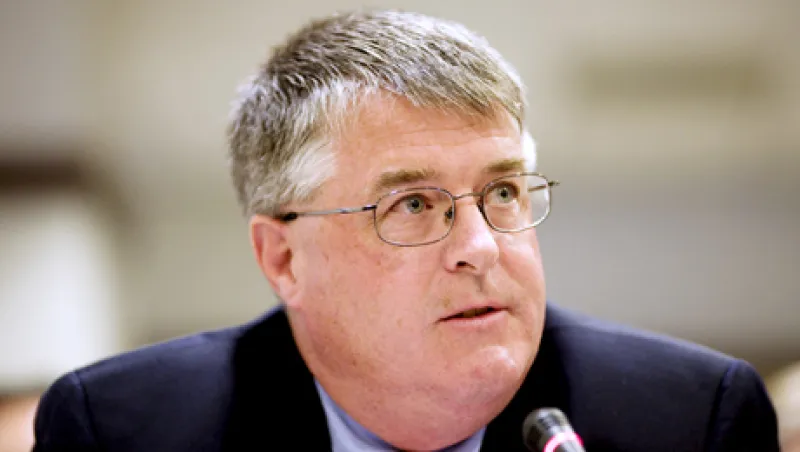On April 25, at the annual Capital Link Closed-End Funds and Global ETFs conference in New York City, John Hyland announced the birth of the National ETF Association (Netfa). Hyland is the chief investment officer at United States Commodity Funds (USCF) of Alameda, California, the sponsor of 12 commodity ETFs — mostly in oil, natural gas, gasoline, and heating oil — and he will be the chairman.
A front-burner issue for the newly formed association is a pilot program proposed by NYSE Arca and Nasdaq OMX, and currently being considered by the SEC, that would allow ETF sponsors to pay the exchanges, who will in turn pay market makers if they make good markets, with tight bid-ask spreads, in thinly traded ETFs. If those pilots go live, Netfa “will throw everyone into a room, and no one leaves the room or goes to the bathroom until we come to a conclusion” about the pros and cons of the different pilots, Hyland says.
Hyland spoke to Institutional Investor contributor Rosalyn Retkwa about the new organization, the potential growth of ETFs, and the need for a dedicated ETF division at the SEC.
1. Why are you starting another trade organization, when the Investment Company Institute already has its ETF committee?
In the U.S., the ETF industry is only 19 years old. Starting about five, six years ago, people started talking about it when we got together at conferences. We [Hyland and Patti] kind of got dragged in voluntarily, like when someone asks you to do something for your local PTA. Volunteers have to do the work to get it going out of the gate, and we’re from companies that don’t have layers and layers of bureaucracy. Both of us work for companies where investment professionals outnumber the lawyers.
2. How will you face the challenge that the biggest ETF issuers — BlackRock, Vanguard, and State Street — have said they will stick with the Investment Company Institute (ICI)?
We think that for some of the biggest ETF firms, the answer to the question of should they go with the ICI versus Netfa is “we will stick with the ICI” and then they say sotto voce “for now.” After all, in some cases their mutual fund business is currently larger than their ETF business. In other cases, they may feel that an organization that bands together all the other ETF sponsors is a bit of a challenge to their industry dominance. I am sure that in 1941 not every mutual fund company joined the ICI when it started and some may have waited years. We at Netfa are fine with whatever decision each ETF sponsor makes. About a dozen firms have said they definitely want to join Netfa, and with a couple of additional firms, the senior ETF people are definitely in favor, but they’ve got their corporate processes to go through. ALPS Funds Services of Denver is definitely in. The history of trade associations would suggest that eventually the ETF sponsors will all end up joining Netfa. I will make a prediction: Going forward, not only will there be one trade group for mutual funds, ICI, and one for ETFs, Netfa, but eventually, there will be a third, for the issuers of Exchange Traded Notes (ETNs). It’s like automobiles versus heavy trucks versus motorcycles. They’ve all got wheels, they’ve all got engines, but motorcycle manufacturers don’t have to worry about air bags, and automobile manufacturers don’t have to worry about helmets.
Most of the time we’ll be on the same page as the ICI, but that won’t always be true. There will be some issues that ETF sponsors care about desperately that aren’t of concern to mutual fund sponsors.
3. Like the proposed pilots to pay market makers to make better markets in thinly-traded ETFs?
All three major exchanges, including BATS, are grappling with how to keep good, tight markets. My USO [United States Oil] ETF will trade one cent wide all day, but if an ETF is showing with a spread of 30, 40 cents, nobody wants to buy or sell, and the market maker doesn’t want to get stuck with carrying inventory. The issue is restoring balance so the risk of being a market maker is balanced by the benefits. A good sign that the pilots are working will be if more firms want to be lead market makers. Our big question is the cost. I don’t think many ETF issuers would balk at throwing some money in if there are measurable benefits, but there is also a limit to our generosity.
4. What other unique problems do ETF sponsors face?
The rules that govern ETFs were never written to govern ETFs. They were written for stocks, bonds, and mutual funds, and adapted for ETFs. So, if you’re an ETF sponsor, dealing with the SEC means dealing with multiple departments, none of which is the ETF department. It’s getting to the point where maybe, as part of Netfa's effort, we want to lobby for a division of ETFs, where everything ETF is done there, so you have informed, dedicated ETF people at the SEC, who would know whether an ETF raises new issues and needs a more detailed review or whether it’s the twelfth in a particular category, and not end up asking so many questions. Getting an ETF approved now takes a year or more if it has a novel structure that raises a lot of questions, while a simpler ETF might get approved in six to nine months. All those times seem longer than what’s really needed for thorough reviews.
5. How much more growth is left in the ETF industry?
Every year, that question gets asked. We don’t know what the limit is, but we definitely won’t get to where we have as many ETFs as we have open-ended mutual funds because most ETFs are indexed. However, there’s one caveat: If we get people creating a lot of actively managed ETFs, then it is possible that could raise the natural limit on the number of ETFs. Right now, some actively managed ETFs have gained some traction, but they’re typically bond funds. It definitely remains one of the big unknowns as to what extent actively managed ETFs will expand beyond certain narrow niches and really get a lot of investor interest.






